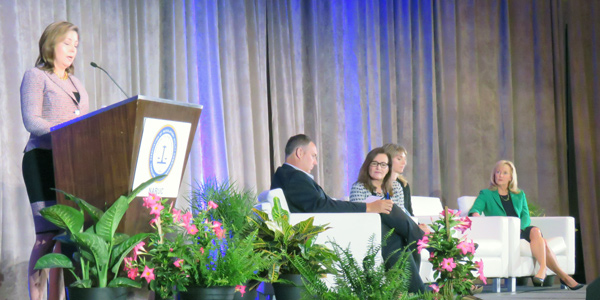By Jason Fordney
SAN DIEGO — New electricity business and regulatory models will be needed in the U.S. to transition to a future with more distributed and renewable resources, changing customer needs and new technologies, market participants and regulators said this week.
Industry representatives and state regulators gave an overview of the changing landscape at the National Association of Regulatory Utility Commissioners Summer Policy Summit. Common themes were the growth of distributed resources, managing large amounts of new renewables and developing fresh approaches as more electricity consumers also become producers.
Pacific Gas and Electric CEO Geisha Williams said that the key is to implement renewables, distributed generation and other new technologies “and not leave anybody behind.” About 40% of the utility’s customers are low-income, and they should not have to choose between paying for electricity and other critical expenses such as health care, she said.
The model of billing energy consumers purely based on the amount of electricity they use is becoming obsolete, Williams said. “That model is fundamentally at risk at this point.”
Many electric consumers are also producers, as behind-the-meter and distributed resources grow. Retail energy sales in the future “may very well likely not be a one-size-fits-all,” she said, similar to how mobile phone users have different data plans because they have widely different needs. This could entail using a tiered approach, service and access charges and new incentives for capital investment.
It is important that regulators and lawmakers put the right policies in place to implement new technologies and practices in an affordable way, Williams said, adding that “affordability is a strategic imperative to us.”
The country’s generation and distribution systems “are really undergoing a period of very dramatic change,” Nuclear Energy Institute CEO Maria Korsnick said. She contended that nuclear, particularly small modular reactors, should play a role in maintaining clean and affordable energy.
“Small modular reactors could be game-changers in many respects,” Korsnick said, providing smaller increments of power compared with a large central station plant and giving utilities more discretion in meeting demand. Modular reactors can also bring off-grid power to remote places and cycle up and down like a natural gas plant — but with no emissions.
In Pennsylvania, distributed resources are “popping up as a result of new opportunities,” Public Utility Commissioner John Coleman said. The agricultural sector is learning that biodigesters can help manage waste products while producing electricity. The question is to how to compensate these new resources.
As for the traditional ratemaking model: “Maybe it is at risk,” Coleman said. “Maybe it is time to start thinking of some of these things in a different way.”
The Pennsylvania PUC is surveying industry on new compensation approaches and ways to incentivize investment. He noted that the majority of the state’s consumers are served by competitive suppliers and electricity rates have dropped by about 30%. Natural gas plants are also rapidly replacing coal-fired units in the state.
Other than distributed resources, utility-scale generation is also changing, according to Ohio Public Utilities Commissioner Beth Trombold. The state has a potential 8,000 MW of new gas-fired generation coming online, with four gas plants under construction, one certified and four more under review. There is about 1,200 MW of new wind and 400 MW of new solar waiting in the wings, which will greatly increase the amount of renewables in the state.
Ohio is also in the middle of a grid modernization program and asking, “What kind of regulations and technological innovation are out there to enhance the customer-utility relationship?” Trombold said.
California Public Utilities Commission Chairman Michael Picker said that integrating renewables in the state has not been as challenging as was feared, and it is now more important to consider where they are placed.
Legislation is in the works in California to achieve a zero-carbon electricity grid by 2045 and the state recently extended its cap-and-trade program to 2030. (See California Lawmakers Extend Cap-and-Trade.)
“At this point, it’s not about getting more, it’s what you get, where you get it … and when it’s available,” Picker said of renewable generation. The state is experiencing lower electricity demand overall but higher peaks. The PUC is moving away from “silos” in terms of what kind of resources are put on the grid, but back to an integrated resource plan model, he said.
In terms of reducing greenhouse gases, more of the transportation sector must be electrified, he said. The transportation sector emits 40% of GHG in the state; gas for heating and other uses emit about 30%, while just 20% is emitted from the electricity generation.




